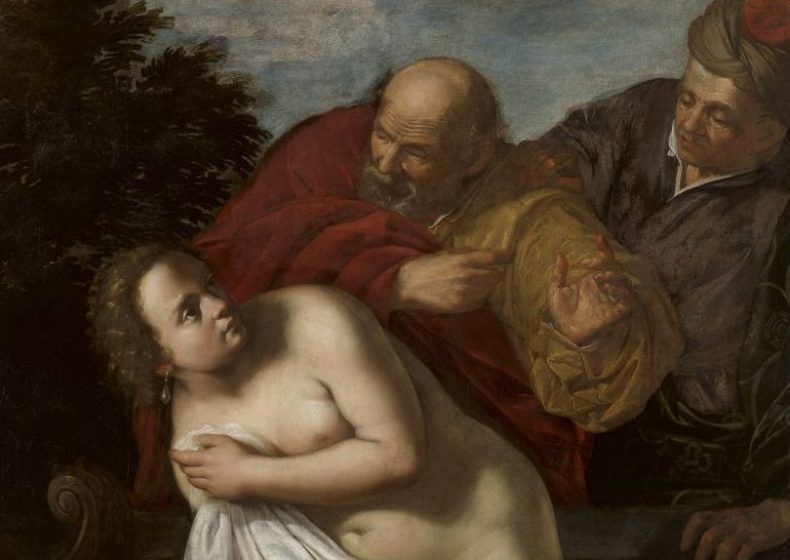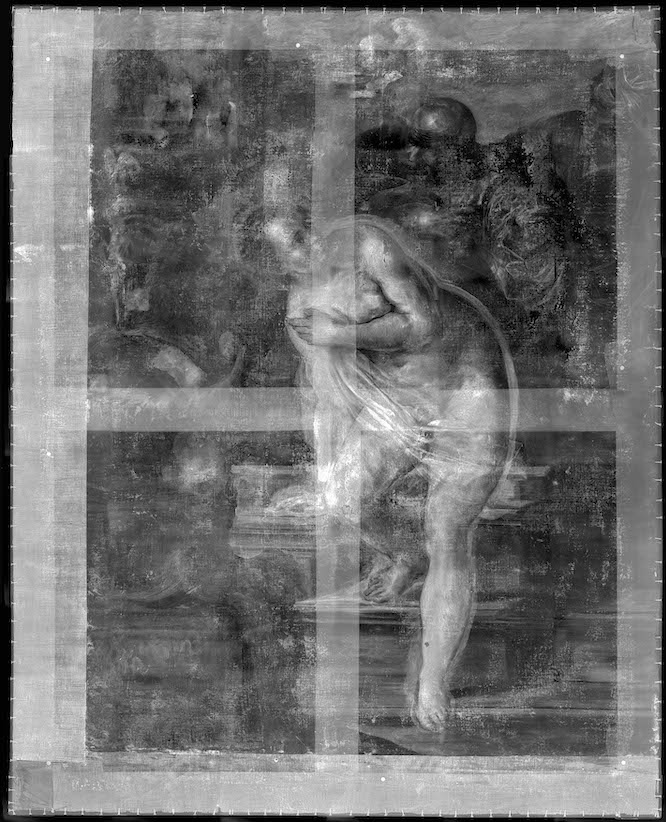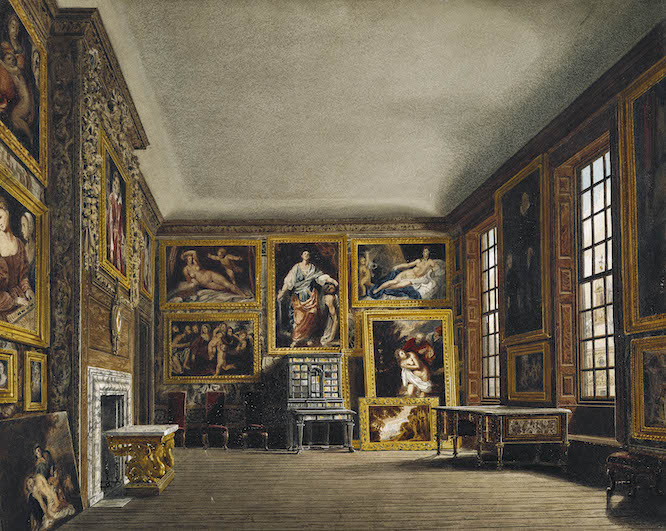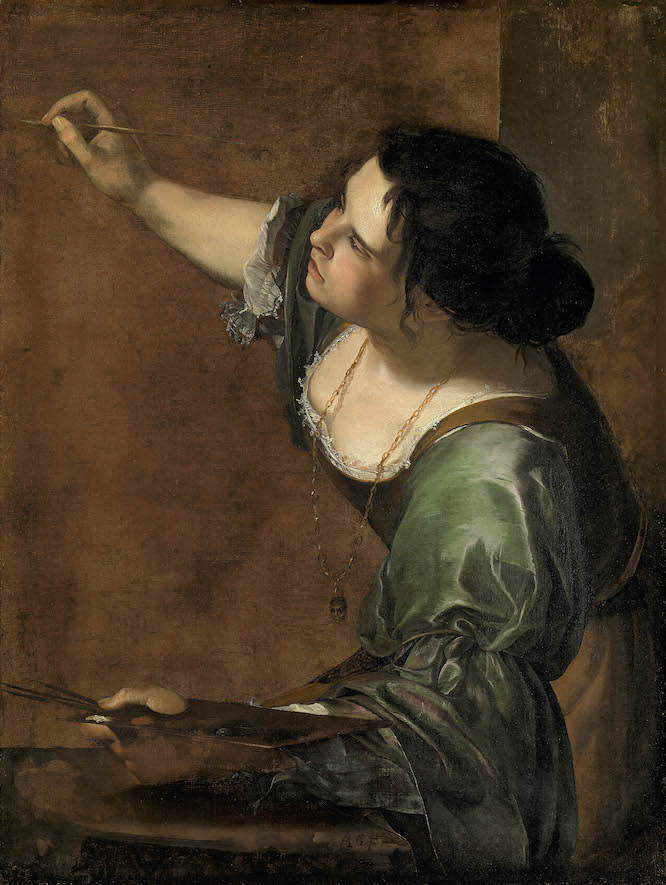The Royal Collection Trust has just announced that it has uncovered a work by the great baroque painter Artemisia Gentileschi: a version of Susanna and the Elders that has been hiding in its care for centuries. This is not the first lost painting to have been found in recent years, but what makes this discovery particularly significant is that the work can be traced directly to a period of Artemisia’s life of which very little is known: her years in London at the court of Charles I and Henrietta Maria.
Charles and Henrietta Maria were avid collectors of Italian art and desperate to have an Italian painter at their court. To this end they had approached the likes of Guido Reni, Guercino and Artemisia, whose father Orazio had been settled there since the 1620s. Orazio had arrived there at the request of the monarch, but Charles showed little interest in him when he arrived. (It is likely that the invitation was in fact instigated by the Duke of Buckingham, whose death in 1628 left Orazio in a precarious situation.) Having put off these invitations for many years, what finally prompted Artemisia to accept, in around 1637/38, is unclear. Perhaps it was the promise of a rich and high-profile patron, or the desire to see her ailing father once again before he died and help him finish his final commissions. They had not seen each other for a long time and had parted on bad terms.

Susanna and the Elders (detail; c. 1638–39), Artemisia Gentileschi. Royal Collection Trust/© His Majesty King Charles III 2023
What Artemisia produced in England has also been obscure, aside from one extant work: Self-Portrait as the Allegory of Painting in the Royal Collection. But this is starting to change. In 2020 a signed David and Goliath that could be confidently attributed to this period was found in France and now, after many years of painstaking research, the Royal Collection Trust has reattributed this Susanna and the Elders, previously listed as ‘unattributed French School’.
The painting has undergone extensive restoration. As an article by Nico Munz and Adelaide Izat in the October issue of the Burlington Magazine discusses, layer upon layer of yellowed varnish and overpaint, and even later extensions to the canvas, were removed and the work beneath has been revived. This process uncovered a wealth of knowledge about Artemisia’s working practices. She will have arrived in London without her studio, and with limited supplies, including a book of templates, which acted like traces to provide outlines that she could quickly use and reuse. X-Rays and Infrared scans show that she used these templates for the figures, which are repeated in other known works: Susanna’s head was used in subsequent Bathshebas, and the ‘suitors’ had been used before. Artemisia then reworked them extensively, painting directly on to the canvas to create her characters and settings.

X-radiography revealed changes that Artemisia made to the composition. Royal Collection Trust/© His Majesty King Charles III 2023
As the investigation continued, the restorers found CR (Carolus Rex) emblazoned on the back: this was the moment when they knew what they had found. Every painting in Charles I’s collection was branded in this way, but this did not necessarily mean that it was commissioned by the king. While there has been renewed interest in Artemisia in recent years, there has also been a reassessment of the scale of Henrietta Maria’s activities as a patron and collector in her own right. This reattribution is almost as significant a discovery regarding the work’s patron as for its painter.
Existing evidence already suggested that it was Henrietta Maria more than Charles who was interested in Artemisia’s work. Abraham van der Doort’s 1639 inventory, combined with the 1649 inventory made for the Commonwealth Sale at the end of the civil war, demonstrate that of the seven works by Artemisia Gentileschi recorded in the collection, the majority were hanging in Henrietta Maria’s apartments and palaces. To add to this, in 1640 Artemisia wrote to the Duke of Modena that she had been painting for ‘Maestà della Regina sua et mia Signora’ (Her Majesty the Queen and my Lady). She referred to Henrietta Maria and her mother, Marie de’ Medici, who was also living at the court at the time and who had previously commissioned works from Artemisia and was a longstanding patron of Orazio. Which is ‘Her Majesty’ and which ‘my Lady’ is hard to say.

The Queen’s Bedchamber, Kensington Palace, c. 1818, Richard Cattermole. Royal Collection Trust/© His Majesty King Charles III 2023
While Artemisia was in London, Henrietta Maria had her apartments at Whitehall Palace entirely redecorated. She was pregnant and soon to enter her confinement. It is from this redecoration that Artemisia’s commission for Susannah can tentatively be dated. When the rooms were completed, it hung in pride of place, over the sumptuous new marble fireplace inscribed with the Queen’s cipher: HMR (Henrietta Maria Regina). It seems likely that it was painted with this location in mind: the steps that Susanna stands on would have visually continued, with the mantlepiece becoming the next step; the flowing fountain beside her would have corresponded with the fire blazing below. This suggests not only a commission, but also a kind of collaboration between the artist and her patron.

Self-Portrait as the Allegory of Painting (c. 1638–39), Artemisia Gentileschi. Royal Collection Trust/© His Majesty King Charles III 2023
The choice of subject may seem curious for a lying in, but Henrietta Maria was known to have surrounded herself with paintings of powerful women from the Bible and from classical literature: Diana the Huntress, The Nine Muses, The Finding of Moses, each of which feature almost entirely female casts. The symbolism of having a painting of the indomitable Susanna in the private rooms of the Queen, by one of the most celebrated artists of the day, a woman, is evident. When compared to Artemisia’s earlier treatments of the story, the Susanna we see in the painting is not cowering or hiding; she looks at her attackers with an expression which is almost placid, defiant. Susanna’s defiance may have taken on a greater meaning for Henrietta Maria as the civil war, and the end of her world as she knew it, drew closer.
Susanna and the Elders is now on display at Windsor Castle, hanging with Artemisia’s other London work in the Royal Collection, Self-Portrait as the Allegory of Painting and with Orazio’s Joseph and Potiphar’s Wife. Its rediscovery is another valuable piece of information about Artemisia’s years in London, but it also reminds us how much may still be out there to find.

Command performance – what a lost Artemisia tells us about an English queen
Susanna and the Elders (detail; c. 1638–39), Artemisia Gentileschi. Royal Collection Trust/© His Majesty King Charles III 2023
Share
The Royal Collection Trust has just announced that it has uncovered a work by the great baroque painter Artemisia Gentileschi: a version of Susanna and the Elders that has been hiding in its care for centuries. This is not the first lost painting to have been found in recent years, but what makes this discovery particularly significant is that the work can be traced directly to a period of Artemisia’s life of which very little is known: her years in London at the court of Charles I and Henrietta Maria.
Charles and Henrietta Maria were avid collectors of Italian art and desperate to have an Italian painter at their court. To this end they had approached the likes of Guido Reni, Guercino and Artemisia, whose father Orazio had been settled there since the 1620s. Orazio had arrived there at the request of the monarch, but Charles showed little interest in him when he arrived. (It is likely that the invitation was in fact instigated by the Duke of Buckingham, whose death in 1628 left Orazio in a precarious situation.) Having put off these invitations for many years, what finally prompted Artemisia to accept, in around 1637/38, is unclear. Perhaps it was the promise of a rich and high-profile patron, or the desire to see her ailing father once again before he died and help him finish his final commissions. They had not seen each other for a long time and had parted on bad terms.
Susanna and the Elders (detail; c. 1638–39), Artemisia Gentileschi. Royal Collection Trust/© His Majesty King Charles III 2023
What Artemisia produced in England has also been obscure, aside from one extant work: Self-Portrait as the Allegory of Painting in the Royal Collection. But this is starting to change. In 2020 a signed David and Goliath that could be confidently attributed to this period was found in France and now, after many years of painstaking research, the Royal Collection Trust has reattributed this Susanna and the Elders, previously listed as ‘unattributed French School’.
The painting has undergone extensive restoration. As an article by Nico Munz and Adelaide Izat in the October issue of the Burlington Magazine discusses, layer upon layer of yellowed varnish and overpaint, and even later extensions to the canvas, were removed and the work beneath has been revived. This process uncovered a wealth of knowledge about Artemisia’s working practices. She will have arrived in London without her studio, and with limited supplies, including a book of templates, which acted like traces to provide outlines that she could quickly use and reuse. X-Rays and Infrared scans show that she used these templates for the figures, which are repeated in other known works: Susanna’s head was used in subsequent Bathshebas, and the ‘suitors’ had been used before. Artemisia then reworked them extensively, painting directly on to the canvas to create her characters and settings.
X-radiography revealed changes that Artemisia made to the composition. Royal Collection Trust/© His Majesty King Charles III 2023
As the investigation continued, the restorers found CR (Carolus Rex) emblazoned on the back: this was the moment when they knew what they had found. Every painting in Charles I’s collection was branded in this way, but this did not necessarily mean that it was commissioned by the king. While there has been renewed interest in Artemisia in recent years, there has also been a reassessment of the scale of Henrietta Maria’s activities as a patron and collector in her own right. This reattribution is almost as significant a discovery regarding the work’s patron as for its painter.
Existing evidence already suggested that it was Henrietta Maria more than Charles who was interested in Artemisia’s work. Abraham van der Doort’s 1639 inventory, combined with the 1649 inventory made for the Commonwealth Sale at the end of the civil war, demonstrate that of the seven works by Artemisia Gentileschi recorded in the collection, the majority were hanging in Henrietta Maria’s apartments and palaces. To add to this, in 1640 Artemisia wrote to the Duke of Modena that she had been painting for ‘Maestà della Regina sua et mia Signora’ (Her Majesty the Queen and my Lady). She referred to Henrietta Maria and her mother, Marie de’ Medici, who was also living at the court at the time and who had previously commissioned works from Artemisia and was a longstanding patron of Orazio. Which is ‘Her Majesty’ and which ‘my Lady’ is hard to say.
The Queen’s Bedchamber, Kensington Palace, c. 1818, Richard Cattermole. Royal Collection Trust/© His Majesty King Charles III 2023
While Artemisia was in London, Henrietta Maria had her apartments at Whitehall Palace entirely redecorated. She was pregnant and soon to enter her confinement. It is from this redecoration that Artemisia’s commission for Susannah can tentatively be dated. When the rooms were completed, it hung in pride of place, over the sumptuous new marble fireplace inscribed with the Queen’s cipher: HMR (Henrietta Maria Regina). It seems likely that it was painted with this location in mind: the steps that Susanna stands on would have visually continued, with the mantlepiece becoming the next step; the flowing fountain beside her would have corresponded with the fire blazing below. This suggests not only a commission, but also a kind of collaboration between the artist and her patron.
Self-Portrait as the Allegory of Painting (c. 1638–39), Artemisia Gentileschi. Royal Collection Trust/© His Majesty King Charles III 2023
The choice of subject may seem curious for a lying in, but Henrietta Maria was known to have surrounded herself with paintings of powerful women from the Bible and from classical literature: Diana the Huntress, The Nine Muses, The Finding of Moses, each of which feature almost entirely female casts. The symbolism of having a painting of the indomitable Susanna in the private rooms of the Queen, by one of the most celebrated artists of the day, a woman, is evident. When compared to Artemisia’s earlier treatments of the story, the Susanna we see in the painting is not cowering or hiding; she looks at her attackers with an expression which is almost placid, defiant. Susanna’s defiance may have taken on a greater meaning for Henrietta Maria as the civil war, and the end of her world as she knew it, drew closer.
Susanna and the Elders is now on display at Windsor Castle, hanging with Artemisia’s other London work in the Royal Collection, Self-Portrait as the Allegory of Painting and with Orazio’s Joseph and Potiphar’s Wife. Its rediscovery is another valuable piece of information about Artemisia’s years in London, but it also reminds us how much may still be out there to find.
Unlimited access from just $16 every 3 months
Subscribe to get unlimited and exclusive access to the top art stories, interviews and exhibition reviews.
Share
Recommended for you
Has a long-lost Artemisia finally come to light?
Painted in around 1625, the Penitent Mary Magdalene inspired a host of copies before disappearing. Now, it has resurfaced in a private collection
After the blast – at the Sursock Palace and Museum in Beirut
Surveying the damage at this landmark suggests how long and difficult the road to rebuild Beirut – once again – will be
London calling – Orazio Gentileschi’s The Finding of Moses at the court of Charles I
The National Gallery is raising funds to purchase Orazio Gentileschi’s biblical scene – once a prized possession of Queen Henrietta Maria